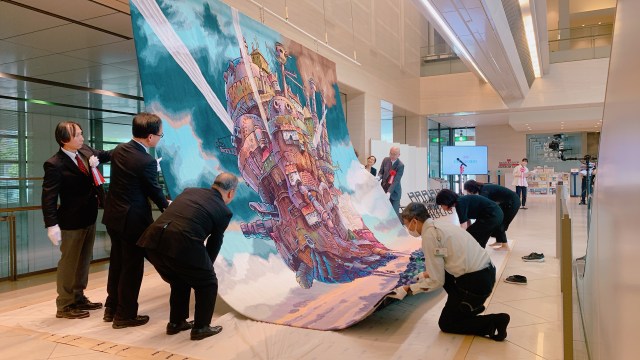
The imagination of Hayao Miyazaki, captured in tapestry, can now be viewed by the public for a limited time.
Back in 2009, the craft of Aubusson tapestry, from the Creuse region of France, was recognised by UNESCO as an Intangible Cultural Heritage. Described as a “gold standard throughout the world”, Aubusson tapestries involve weaving an image using 600-year-old techniques to produce rugs and large decorative wall hangings, and though the process is difficult and time-consuming, it produces jaw-dropping results.
The craft is so respected that Studio Ghibli, the acclaimed Japanese anime studio that flies the flag for traditional processes while fiercely protecting its works, allowed Aubusson’s Cité Internationale de la Tapisserie museum to create five Aubusson tapestries based on images from the animated films of director Hayao Miyazaki.
The first of the giant tapestries in the so-called “L’imaginaire d’Hayao Miyazaki en tapisserie d’Aubusson” (“The imagination of Hayao Miyazaki in Aubusson Tapestry“) series depicts a forest scene from the 1997 film Princess Mononoke, and was unveiled in France in March 2022.
▼ Watch the live unveiling in this cued-up clip below.
▼ The second tapestry, unveiled in January last year, recreates a scene from the 2001 movie, Spirited Away.
▼ In April last year, the third work, featuring Howl’s Castle from Howl’s Moving Castle, was unveiled.
While the final two designs — featuring scenes from Nausicaä of the Valley of the Wind and My Neighbour Totoro — are yet to be made public, the latest tapestry, showing Howl’s Moving Castle at dusk, has now made the journey from France to Japan for the very first time.
The five-metre (16.4-foot) square tapestry was unveiled at a ceremony at the Hiroshima Prefectural Museum of Art on 1 July, with curators from Aubusson’s Cité Internationale de la Tapisserie and Studio Ghibli staff in attendance.
Ghibli’s Executive Officer, Shinsuke Nonaka, who was approached in 2018 by representatives from Aubusson for the project, praised the tapestry, saying, “Although it is elaborate, it has a warmth that can only be brought about by handmade processes, and its large size makes it very impressive.”
After seeing it for the first time in Japan, Nonaka said he was glad to have agreed to the project, commenting on how well the film’s worldview had been captured in the tapestry.
▼ Shinsuke Nonaka
Given its size, the tapestry is impressive both up close and from a distance, which is good news for visitors to the museum, as it will be displayed in the lobby for a limited time.
The tapestry will be displayed from 2 July and will remain up for the duration of the “Friday Roadshow and Ghibli Exhibition” being held at the Hiroshima Prefectural Museum of Art from 13 July to 25 September. The museum will be closed on 8 July, but aside from that day, members of the public will be able to view the giant tapestry even if they aren’t attending the Ghibli Exhibition, as tickets aren’t required to enter the lobby where it’s displayed.
As one of the few remaining anime studios creating animation by hand, it’s nice to see Studio Ghibli throwing its support behind other handmade crafts, and when it comes to supporting local Japanese arts and crafts, Ghibli has a wealth of experience there too!
Source. images: PR Times
● Want to hear about SoraNews24’s latest articles as soon as they’re published? Follow us on Facebook and Twitter!

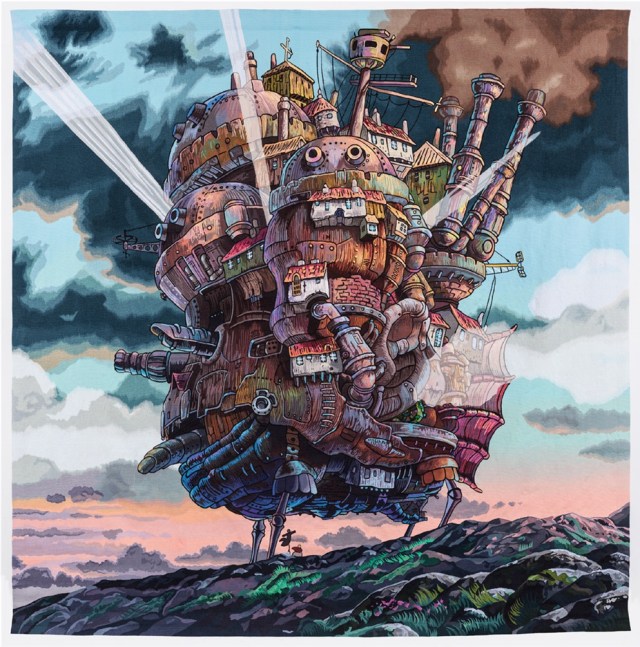
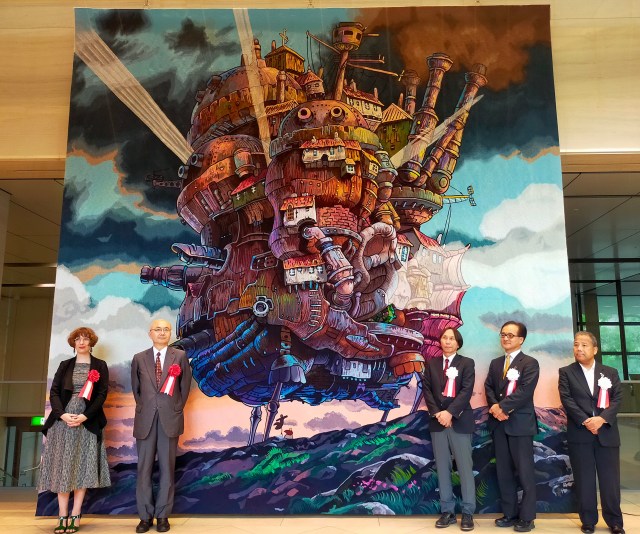

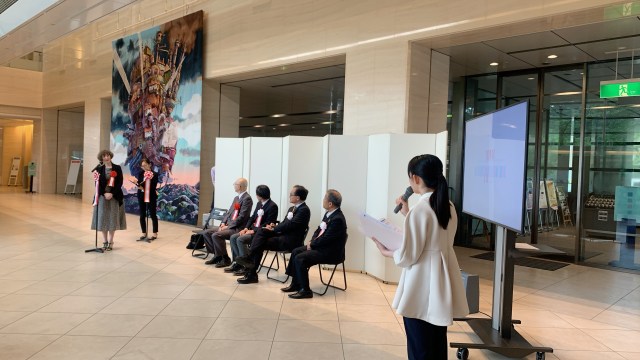
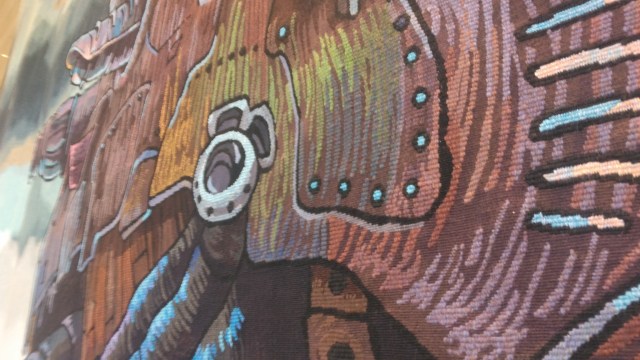
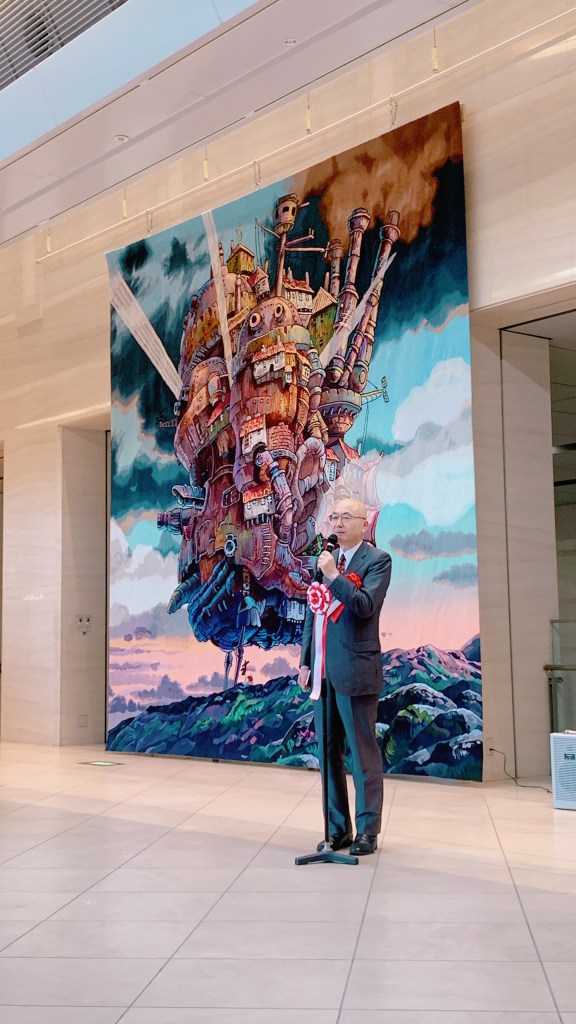
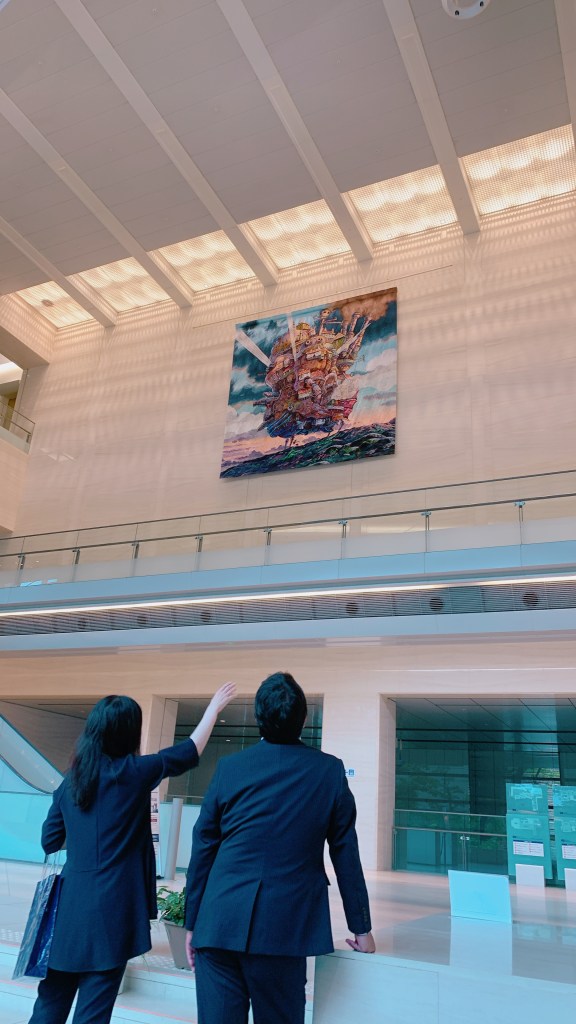
 Studio Ghibli tattoos feature our favourites from Totoro, Spirited Away and Howl’s Moving Castle
Studio Ghibli tattoos feature our favourites from Totoro, Spirited Away and Howl’s Moving Castle Ghibli releases a Howl’s Moving Castle that walks and lights up【Video】
Ghibli releases a Howl’s Moving Castle that walks and lights up【Video】 Ghibli Park unveils new real-life Howl’s Moving Castle!
Ghibli Park unveils new real-life Howl’s Moving Castle! Howl’s Moving Castle is now a die-cast car in Studio Ghibli anime toy line, and Calcifer too!【Pics】
Howl’s Moving Castle is now a die-cast car in Studio Ghibli anime toy line, and Calcifer too!【Pics】 New Studio Ghibli Howl’s Moving Castle die-cast toy cars on sale today, new preview pics shown
New Studio Ghibli Howl’s Moving Castle die-cast toy cars on sale today, new preview pics shown Starbucks Japan releases new drinkware and goods for Valentine’s Day
Starbucks Japan releases new drinkware and goods for Valentine’s Day We followed Tokyo’s mystery walking map and ended up creating our own bar-hopping adventure
We followed Tokyo’s mystery walking map and ended up creating our own bar-hopping adventure We try an unusual buffet of dishes made from wild game at a roadside stop in Chiba
We try an unusual buffet of dishes made from wild game at a roadside stop in Chiba Play games, learn, and get your fortune at Ginza’s limited-time Tsunaguu “Shrine of the Future”
Play games, learn, and get your fortune at Ginza’s limited-time Tsunaguu “Shrine of the Future” Japanese shiitake mushroom snacks from Don Quijote, created for people who don’t like mushrooms
Japanese shiitake mushroom snacks from Don Quijote, created for people who don’t like mushrooms The new Ranma 1/2 anime is here! So is it worth watching?【SoraReview】
The new Ranma 1/2 anime is here! So is it worth watching?【SoraReview】 7 great places to see Mt. Fuji from without having to climb it
7 great places to see Mt. Fuji from without having to climb it Japan’s otoshidama tradition of giving kids money at New Year’s gets a social welfare upgrade
Japan’s otoshidama tradition of giving kids money at New Year’s gets a social welfare upgrade Japanese women’s breasts get dismal satisfaction evaluation…from their owners
Japanese women’s breasts get dismal satisfaction evaluation…from their owners Draw like a Studio Ghibli anime artist with exclusive watercolour set approved by Hayao Miyazaki
Draw like a Studio Ghibli anime artist with exclusive watercolour set approved by Hayao Miyazaki 10 times to avoid traveling in Japan in 2026
10 times to avoid traveling in Japan in 2026 Our 52-year-old pole dancing reporter shares his tips for achieving your New Year’s exercise goal
Our 52-year-old pole dancing reporter shares his tips for achieving your New Year’s exercise goal Starbucks Japan releases new Frappuccino and latte for Valentine’s Day
Starbucks Japan releases new Frappuccino and latte for Valentine’s Day Ramen restaurant’s English menu prices are nearly double its Japanese ones, denies discriminating
Ramen restaurant’s English menu prices are nearly double its Japanese ones, denies discriminating Princess Mononoke magnets return just in time to treat yourself to awesome anime decorations
Princess Mononoke magnets return just in time to treat yourself to awesome anime decorations Umamusume anime girl plushie recalled for having parts she absolutely should not have【Pics】
Umamusume anime girl plushie recalled for having parts she absolutely should not have【Pics】 Giant hotel rooms in Osaka reflect the new non-niche face of travel in Japan.
Giant hotel rooms in Osaka reflect the new non-niche face of travel in Japan. Japanese women showing rebounding interest in giving Valentine’s Day chocolate【Survey】
Japanese women showing rebounding interest in giving Valentine’s Day chocolate【Survey】 We ate sushi made from Japan’s most expensive tuna ever【Taste test】
We ate sushi made from Japan’s most expensive tuna ever【Taste test】 Starbucks Japan ready to get Year of the Horse started with adorable drinkware and plushies【Pics】
Starbucks Japan ready to get Year of the Horse started with adorable drinkware and plushies【Pics】 7-Eleven Japan starts new temporary luggage storage service in over 300 branches
7-Eleven Japan starts new temporary luggage storage service in over 300 branches Disillusionment at Tsukiji’s tourist-target prices led us to a great ramen restaurant in Tokyo
Disillusionment at Tsukiji’s tourist-target prices led us to a great ramen restaurant in Tokyo Starbucks teams up with 166-year-old Kyoto doll maker for Year of the Horse decorations【Photos】
Starbucks teams up with 166-year-old Kyoto doll maker for Year of the Horse decorations【Photos】 Tokyo’s Tsukiji sushi neighborhood asks tour groups to stay away for the rest of the month
Tokyo’s Tsukiji sushi neighborhood asks tour groups to stay away for the rest of the month Survey asks foreign tourists what bothered them in Japan, more than half gave same answer
Survey asks foreign tourists what bothered them in Japan, more than half gave same answer Japan’s human washing machines will go on sale to general public, demos to be held in Tokyo
Japan’s human washing machines will go on sale to general public, demos to be held in Tokyo We deeply regret going into this tunnel on our walk in the mountains of Japan
We deeply regret going into this tunnel on our walk in the mountains of Japan Studio Ghibli releases Kodama forest spirits from Princess Mononoke to light up your home
Studio Ghibli releases Kodama forest spirits from Princess Mononoke to light up your home Major Japanese hotel chain says reservations via overseas booking sites may not be valid
Major Japanese hotel chain says reservations via overseas booking sites may not be valid Put sesame oil in your coffee? Japanese maker says it’s the best way to start your day【Taste test】
Put sesame oil in your coffee? Japanese maker says it’s the best way to start your day【Taste test】 No more using real katana for tourism activities, Japan’s National Police Agency says
No more using real katana for tourism activities, Japan’s National Police Agency says Starbucks Japan reveals new sakura drinkware collection, inspired by evening cherry blossoms
Starbucks Japan reveals new sakura drinkware collection, inspired by evening cherry blossoms Updated cherry blossom forecast shows extra-long sakura season for Japan this year
Updated cherry blossom forecast shows extra-long sakura season for Japan this year Human washing machine pods coming to Japanese hotels【Photos】
Human washing machine pods coming to Japanese hotels【Photos】 Studio Ghibli displays The Boy and the Heron Academy Award Oscar in Japan for a limited time
Studio Ghibli displays The Boy and the Heron Academy Award Oscar in Japan for a limited time Studio Ghibli anime to stream online in Japan for first time ever, but not from any deal with Ghibli
Studio Ghibli anime to stream online in Japan for first time ever, but not from any deal with Ghibli
Leave a Reply